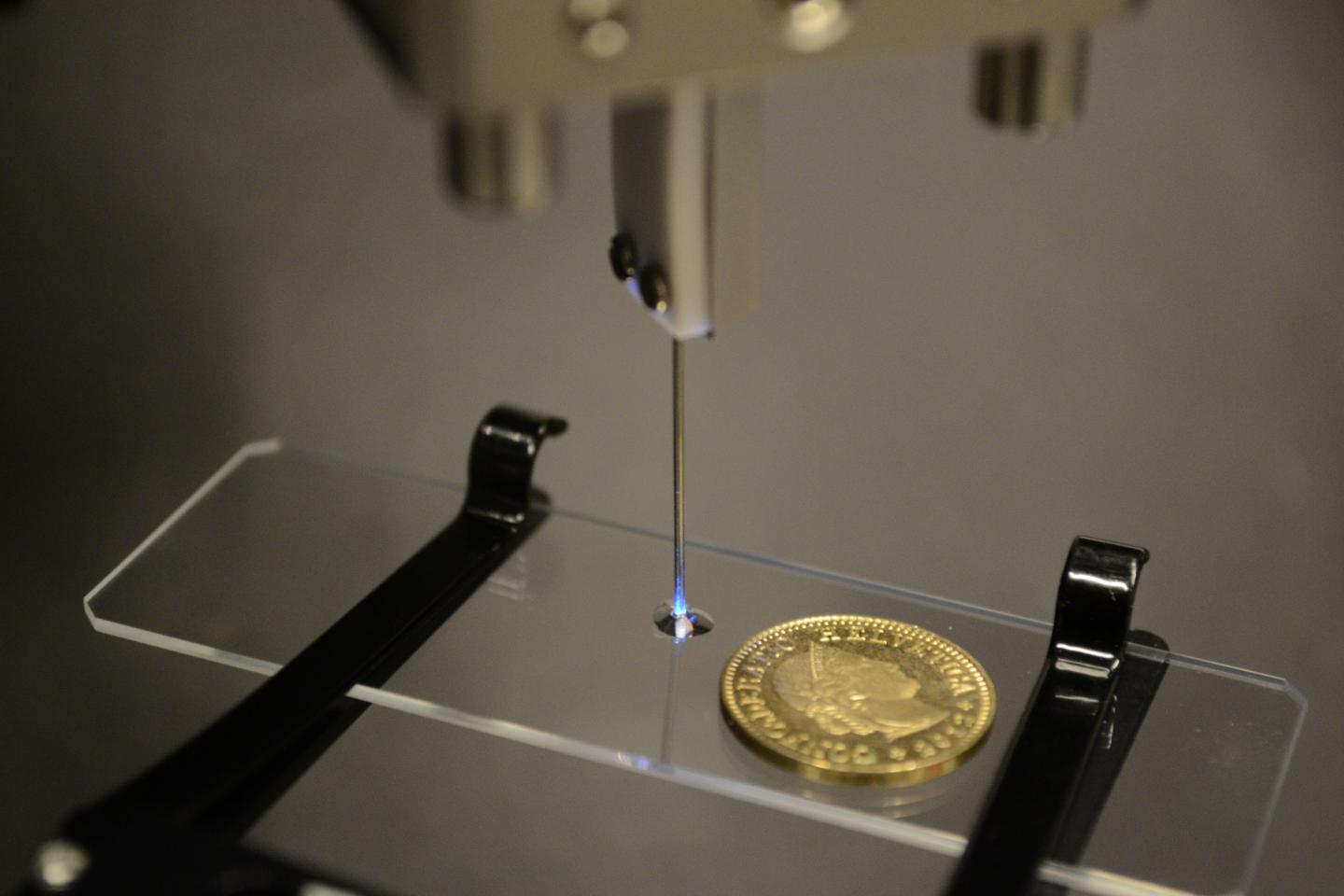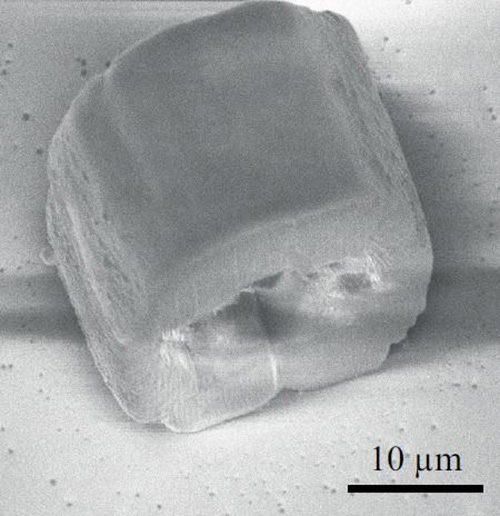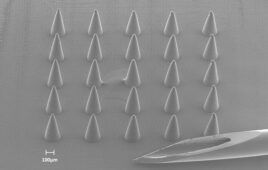For the first time, researchers have shown that an optical fiber as thin as a human hair can be used to create microscopic structures with laser-based 3D printing. The innovative approach might one day be used with an endoscope to fabricate tiny biocompatible structures directly into tissue inside the body. This capability could enable new ways to repair tissue damage.
“With further development our technique could enable endoscopic microfabrication tools that would be valuable during surgery,” said research team leader Paul Delrot, from École Polytechnique Fédérale de Lausanne, Switzerland. “These tools could be used to print micro- or nano-scale 3D structures that facilitate the adhesion and growth of cells to create engineered tissue that restores damaged tissues.”

Researchers used an optical fiber housed inside the needle pictured to deliver light for 3-D printing microstructures. The light selectively hardens volumes inside the droplet of photopolymer on the glass slide. The new system could one day allow 3-D printing inside the body. (Credit: Damien Loterie and Paul Delrot, École Polytechnique Fédérale de Lausanne)
In The Optical Society (OSA) journal Optics Express, the researchers show that their new approach can create microstructures with a 1.0-micron lateral (side-to-side) and 21.5-micron axial (depth) printing resolution. Although these microstructures were created on a microscope slide, the approach could be useful for studying how cells interact with various microstructures in animal models, which would help pave the way for endoscopic printing in people.
To create the microstructures, the researchers dipped the end of an optical fiber into a liquid known as photopolymer that solidifies, or cures, when illuminated with a specific color of light. They used the optical fiber to deliver and digitally focus laser light point-by-point into the liquid to build a three-dimensional microstructure.
By printing delicate details onto large parts, the new ultra-compact microfabrication tool could also be a useful add-on to today’s commercially available 3D printers that are used for everything from rapid prototyping to making personalized medical devices. “By using one printer head with a low resolution for the bulk parts and our device as a secondary printer head for the fine details, multi-resolution additive manufacturing could be achieved,” said Delrot.
Simplifying the setup
Current laser-based microfabrication techniques rely on a non-linear optical phenomenon called two-photon photopolymerization to selectively cure a volume deep inside a liquid photosensitive material. These techniques are difficult to use for biomedical applications because two-photon photopolymerization requires complex and expensive lasers that emit very short pulses as well as bulky optical systems to deliver the light.
“Our group has expertise in manipulating and shaping light through optical fibers, which led us to think that microstructures could be printed with a compact system. In addition, to make the system more affordable, we took advantage of a photopolymer with a nonlinear dose response. This can work with a simple continuous-wave laser, so expensive pulsed lasers were not required,” said Delrot.
To selectively cure a specific volume of material, the researchers took advantage of a chemical phenomenon in which solidification only occurs above a certain threshold in light intensity. By performing a detailed study of the light scanning parameters and the photopolymer’s behavior, the researchers discovered the best parameters for using this chemical phenomenon to print microstructures using a low-power, inexpensive laser that emits continuously (rather than pulsed).
To create hollow and solid microstructures, the researchers used an organic polymer precursor doped with photoinitiator made of off-the-shelf chemical components. They focused a continuous-wave laser emitting light at 488-nanometer wavelength — visible-wavelength light that is potentially safe for cells — through an optical fiber small enough to fit in a syringe. Using an approach known as wavefront shaping they were able to focus the light inside the photopolymer so that only a small 3D point was cured. Performing a calibration step prior to microfabrication allowed them to digitally focus and scan laser light through the ultra-thin optical fiber without moving the fiber.
“Compared to two-photon photopolymerization state-of-the-art systems, our device has a coarser printing resolution, however, it is potentially sufficient to study cellular interactions and does not require bulky optical systems nor expensive pulsed lasers,” said Delrot. “Since our approach doesn’t require complex optical components, it could be adapted to use with current endoscopic systems.”

Using an inexpensive laser and an ultrathin optical fiber, the researchers created hollow microstructures such as the one shown here. They were able to create microstructures with a 1.0-micron lateral (side-to-side) and 21.5-micron axial (depth) printing resolution. (Credit: Paul Delrot, École Polytechnique Fédérale de Lausanne)
Moving toward clinical use
The researchers are working to develop biocompatible photopolymers and a compact photopolymer delivery system, which are necessary before the technique could be used in people. A faster scanning speed is also needed, but in cases where the instrument size is not critical, this limitation could be overcome by using a commercial endoscope instead of the ultra-thin fiber. Finally, a technique to finalize and post-process the printed structure inside the body is required to create microstructures with biomedical functions.
“Our work shows that 3D microfabrication can be achieved with techniques other than focusing a high-power femtosecond pulsed laser,” said Delrot. “Using less complex lasers or light sources will make additive manufacturing more accessible and create new opportunities of applications such as the one we demonstrated.”




